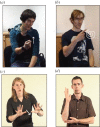The bridge of iconicity: from a world of experience to the experience of language
- PMID: 25092668
- PMCID: PMC4123679
- DOI: 10.1098/rstb.2013.0300
The bridge of iconicity: from a world of experience to the experience of language
Erratum in
- Philos Trans R Soc Lond B Biol Sci. 2014 Oct 19;369(1654):20140179
Abstract
Iconicity, a resemblance between properties of linguistic form (both in spoken and signed languages) and meaning, has traditionally been considered to be a marginal, irrelevant phenomenon for our understanding of language processing, development and evolution. Rather, the arbitrary and symbolic nature of language has long been taken as a design feature of the human linguistic system. In this paper, we propose an alternative framework in which iconicity in face-to-face communication (spoken and signed) is a powerful vehicle for bridging between language and human sensori-motor experience, and, as such, iconicity provides a key to understanding language evolution, development and processing. In language evolution, iconicity might have played a key role in establishing displacement (the ability of language to refer beyond what is immediately present), which is core to what language does; in ontogenesis, iconicity might play a critical role in supporting referentiality (learning to map linguistic labels to objects, events, etc., in the world), which is core to vocabulary development. Finally, in language processing, iconicity could provide a mechanism to account for how language comes to be embodied (grounded in our sensory and motor systems), which is core to meaningful communication.
Keywords: co-speech gesture; iconicity; language development; language evolution; language processing; sign language.
Figures





References
-
- Quinto-Pozos D. 2007. Can constructed action be considered obligatory? Lingua 117, 1285–1314. (10.1016/j.lingua.2005.12.003) - DOI
-
- Kendon A. 1980. Gesticulation and speech: two aspects of the process of utterance. In Relationship of verbal and nonverbal communication (ed. Key MR.), pp. 207–228. The Hague, The Netherlands: Mouton.
-
- McClave E. 2001. The relationship between spontaneous gestures of the hearing and American Sign Language. Gesture 1, 51–72. (10.1075/gest.1.1.05mcc) - DOI
Publication types
MeSH terms
LinkOut - more resources
Full Text Sources
Other Literature Sources
